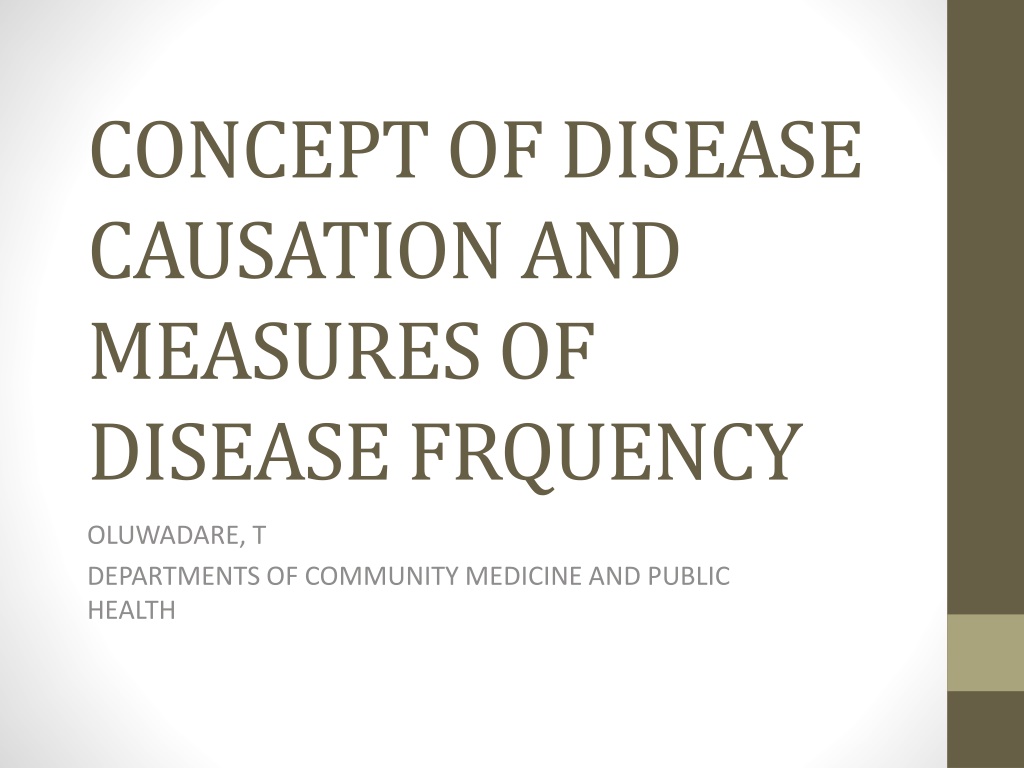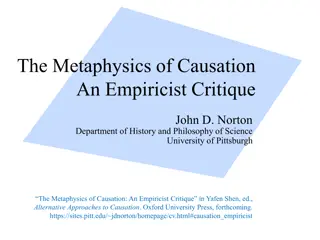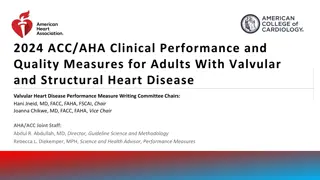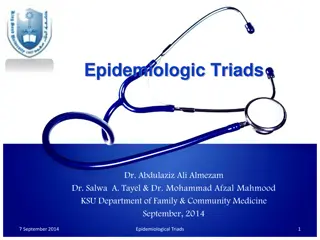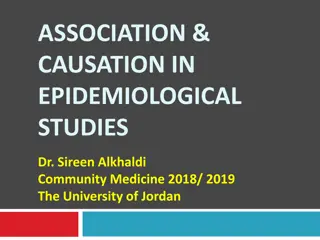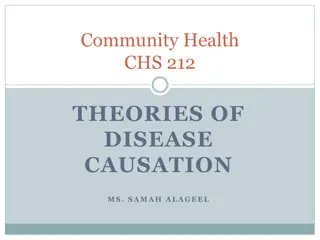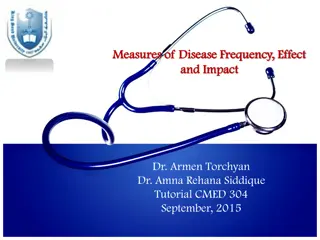Understanding Disease Causation and Frequency Measures
The concept of disease causation delves into the factors that play a role in the development of diseases, emphasizing the importance of studying causation for prevention, control, and treatment. To infer causation, certain conditions must be met, and a causal relationship is characterized by association, time order, and direction. Causal inference is the process of determining likely causal relationships from observed associations.
Download Presentation

Please find below an Image/Link to download the presentation.
The content on the website is provided AS IS for your information and personal use only. It may not be sold, licensed, or shared on other websites without obtaining consent from the author. Download presentation by click this link. If you encounter any issues during the download, it is possible that the publisher has removed the file from their server.
E N D
Presentation Transcript
CONCEPT OF DISEASE CAUSATION AND MEASURES OF DISEASE FRQUENCY OLUWADARE, T DEPARTMENTS OF COMMUNITY MEDICINE AND PUBLIC HEALTH
Introduction What is health? What is a disease/ disease state?
Concept of dx causation A cause of a disease is an event, condition, characteristic, or combination of these factors which plays an important role in producing the disease. A cause could be sufficient or necessary
Concept of dx causation contd. Why study causation? It deepens our understanding of diseases and how they are caused It provides entry point(s) for prevention, control and treatment It contributes to reduction in morbidity and mortality It is helpful in diagnosis and the application of treatment
Concept of dx causation contd. To infer causation, the following conditions must have been met: The study has an adequate sample size The study is free of bias Adjustment for possible confounders has been done There is an association between exposure of interest and the disease outcome
Concept of dx causation contd. Causal relationship Mervyn Susser proposes that in epidemiology, a causal relationship has the following attributes Association; Time order; and Direction
Concept of dx causation contd. Causal relationship Association: A cause must be associated with the effect Time order: The cause must be present before or at least at the same time as its effect (OR, RR) Direction: Risk of disease increases or decreases as the dose of risk factor increases or decreases (i.e. dose- response relationship).
Concept of dx causation contd. Causal inference Causal inference is the term used for the process of determining whether observed associations are likely to be causal
Concept of dx causation contd. Factors in causation Predisposing factors They create a state of susceptibility to a disease agent e.g. age, sex, family history. These may have no direct bearing on the cause of the disease, but they aid other risk factors Enabling factors Environmental conditions which favourthe development of disease e.g. poor nutrition, low income, inadequate medical facility
Concept of dx causation contd. Factors in causation Precipitating factors Specific agent or exposure to which can be associated with the onset of the a disease e.g. pollens in asthmatic attack Reinforcing factors They aggravate an already established disease, state or condition e.g. repeated exposure
Concept of dx causation contd. Germ theory of disease The germ theory of disease states that some diseases are caused by microorganisms.
Concept of dx causation contd. Web of causation theory Disease never depends upon single isolated cause rather it develops from a chain of causation in which each link itself is a result of complex interaction of preceding events . This chain of causation which may be the fraction of the whole complex is known as web of causation.
Concept of dx causation contd. Epidemiological triad Environment Agent Host
Concept of dx causation contd. Epidemiological triad It is the traditional model for infectious diseases Agent Host Environment
Concept of dx causation contd. Multifactorial causation This theory helps to understand the various associated causative factors, which suggests preventive and plan measures to control the disease. Risk factor is a characteristic (socio- demographic, behavioral, lifestyle, environmental) which based on epidemiologic evidence is known to be associated with health related condition or diseases
Concept of dx causation contd. Multifactorial causation Rothman s causal pies The individual factor that contributes to cause disease is shown as a piece of a pie After all the pieces of the pie fall into place, the disease occurs. The individual factors are called component causes. The complete pie, might be considered a causal pathway called sufficient cause
Concept of dx causation contd. Multifactorial causation Rothman s causal pies Sufficient cause A disease may have more than one sufficient cause It inevitably/certainly produces or initiates a disease It is not usually a single factor, but often comprises several components. E.g. cigarette smoking is one component of the sufficient cause in lung cancer
Concept of dx causation contd. Sufficient cause It is not necessary to identify all the components of a sufficient cause before effective prevention can take place, since the removal of one component may interfere with the action of the others and thus prevent the disease.
Concept of dx causation contd. Rothman s causal pies A component that appears in every pie or pathway s called a necessary cause Necessary cause The disease cannot develop in its absence e.g Mycobacterium tuberculosis in TB Each sufficient cause has a necessary cause as a component.
Rothmans causal pies Sufficient cause I Sufficient cause II E H A D A G B B C F
Concept of dx causation contd. Unifactorial theory This theory states that is one single specific cause of every disease.
Concept of dx causation contd. Koch s postulate The organism must be found in abundance in all organisms suffering from the disease, but should not be found in healthy organisms. The organism must be isolated from a diseased organism and grown in pure culture.
Concept of dx causation contd. Koch s postulate contd. The cultured organism should cause disease when introduced into a healthy organism. The organism must be re-isolated from the inoculated, diseased experimental host and identified as being identical to the original specific causative agent.
Concept of dx causation contd. Limitation of Koch s postulate The causative organism may disappear when the disease develops Certain microorganisms cannot (at the present time) be grown in pure culture
Concept of dx causation contd. Limitation of Koch s postulate Not all organisms exposed to infectious agent will acquire the infection. Not all diseases are caused by biological agents
Measures of disease frequency The basic measure of disease frequency are rates, ratio and proportion. Rates are essential for comparing disease frequency in different populations or subgroups of the same population in relation to suspected causal factors.
Measures of disease frequency contd. Measurements in epidemiology Measurement of mortality Measurement of morbidity Measurement of disability Measurement of natality Measurement of demographic variables
Measures of disease frequency contd. Measurements in epidemiology Measurement of the presence, absence or distribution of the characteristic or attributes of the disease Measurement of medical needs, health care facilities, utilization of health services and other health-related events Measurement of the presence, absence or distribution of the environmental and other factors suspected of causing the disease
Measures of disease frequency contd. Basic requirements of measurements are Validity Reliability Accuracy Sensitivity Specificity
Measures of disease frequency contd. Rate It measures the occurrence of some particular event in a population during a given time period. It is a statement of the risk of developing a condition. It indicates the change in some event that takes place in a population over a period of time. Death rate= Number of deaths in one year x 1000 Mid-year population
Measures of disease frequency contd. Categories of rates are : Crude rates: These are the actual observed rates such as the birth and death rates. Crude rates are also known as unstandardized rates. Specific rates: These are the actual observed rates due to specific causes ; or occurring in specific groups or during specific time periods. Standardized rates: These are obtained by direct or indirect method of standardization or adjustment, e.g., age and sex standardized rates
Measures of disease frequency contd. Ratio It expresses a relation in size between two random quantities. The numerator is not a component of the denominator. The numerator and denominator may involve an interval of time or may be instantaneous in time. Broadly, ratio is the result of dividing one quantity by another.
Measures of disease frequency contd. Ratio It is expressed in the form of: z:y or z Example A: A city of 4,000,000 persons has 500 clinics. Calculate the ratio of clinics per person. 500 4,000,000 = 1 clinics per 8000 persons y
Measures of disease frequency contd. Ratio Example B: Delaware s infant mortality rate in 2001 was 10.7 per 1,000 live births. New Hampshire s infant mortality rate in 2001 was 3.8 per 1,000 live births. Calculate the ratio of the infant mortality rate in Delaware to that in New Hampshire. 10.7 3.8 1 = 2.8:1 Thus, Delaware s infant mortality rate was 2.8 times as high as New Hampshire s
Measures of disease frequency contd. Proportion It is a ratio which indicates the relation in magnitude of a part of the whole. The numerator is always included in the denominator. A proportion is usually expressed as a percentage. The number of children with scabies at a certain time Example A: Number of children with scabies at a certain time The total number of children in the village at the same time x 100
Measures of disease frequency contd. Example B Calculate the proportion of deaths among men. Numerator = deaths in men = 100 deaths in diabetic men + 811 deaths in nondiabetic men = 911 deaths in men Notice that the numerator (911 deaths in men) is a subset of the denominator. Denominator = all deaths = 911 deaths in men + 72 deaths in diabetic women + 511 deaths in nondiabetic women = 1,494 deaths Proportion = 911 1,494 = 60.98% = 61%
Measures of disease frequency contd. Morbidity rates There are three aspects of morbidity namely, the frequency, duration and severity Incidence rate Prevalence rate
Measures of disease frequency contd. Morbidity rate incidence rate It is the number of new cases occurring in a defined population during a specific period of time They are used for acute conditions incidence= Number of new cases of specific disease during a given time period X 1000 Population at-risk during that period It is always expressed as follows 32.8 per 1000 per year
Measures of disease frequency contd. Morbidity rate Incidence rate Special incidence rates Attack rate It is used only when the population is exposed to risk for a limited period of time such as during an epidemic Attack rate = Number of new cases of specific disease during a specified time interval X 100 Total Population at-risk during that same time interval Secondary attack rate Number of exposed persons developing the disease within the range of the incubation period X 100 Total number of exposed/ susceptible contacts
Measures of disease frequency contd. Morbidity rate Incidence rate Uses To control diseases To research into aetiology and pathogenesis, distribution of disease and efficacy of preventive and therapeutic measures.
Measures of disease frequency contd. Morbidity rate Prevalence rate Prevalence rate= Total number of people who have an attribute/ disease during at a given period of time Population at-risk of having the attribute/disease at this point in time/ midway through the period
Measures of disease frequency contd. Morbidity rate Types of prevalence rate Point prevalence Period prevalence Uses It helps to estimate the magnitude of health/disease problems in the community and identify potential health risks They are useful for administrative planning purposes
Measures of disease frequency contd. Mortality rates and ratio Crude death rate Specific death rate Case fatality rate Survival rate Adjusted and standardized rates
Assignment Mortality rates and ratio Crude death rate Specific death rate Case fatality rate .. Survival rate . Adjusted and standardized rates.. The formulas for point and period prevalence . The relationship between Prevalence and incidence.
